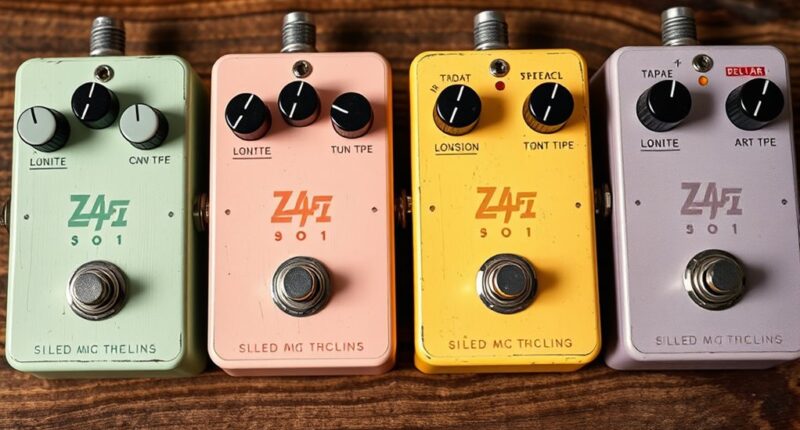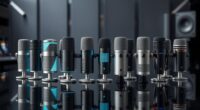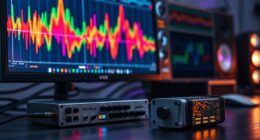If you’re after vintage warmth and lo-fi charm, I recommend trying the Donner White Tape Stereo Delay for classic tape echo sounds, the Tape Delay Guitar Pedal (AFOT) with versatile modulation effects, the Electro-Harmonix Pico Rerun for authentic saturation and flutter, and the Strymon Deco Doubletracker for a range of tape-like textures. Each offers unique controls and authentic tone, making them great options. Keep exploring to find the perfect one to add that vintage character to your sound.
Key Takeaways
- Look for pedals that convincingly emulate vintage tape characteristics like wow, flutter, and saturation for authentic warmth.
- Prioritize models offering versatile delay times, saturation levels, and modulation effects to shape a rich, lo-fi sound.
- Choose pedals with intuitive controls and visual indicators for easy real-time adjustments during performances or recordings.
- Opt for durable, well-built units with positive user reviews to ensure longevity and reliable vintage tone reproduction.
- Consider compatibility with your existing gear and budget to find the best balance of sound authenticity and value.
Donner White Tape Stereo Delay Pedal
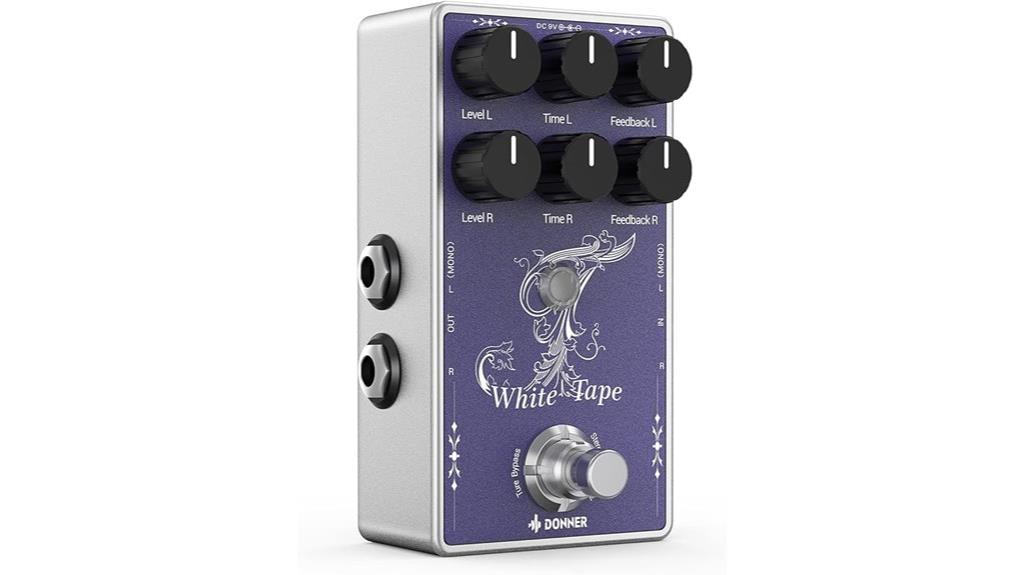
The Donner White Tape Stereo Delay Pedal is an excellent choice for musicians seeking authentic tape echo sounds with a versatile, compact design. Its small footprint (4.5 x 2.1 x 2.7 inches) makes it easy to integrate into any setup, while true bypass preserves your tone. Designed for guitars, bass, synthesizers, or drum machines, it offers independent stereo channels with intuitive controls for Time, Feedback, and Level. You can dial in delay times from 25ms to 1000ms, creating everything from quick slapbacks to lush echoes. Its analog dry signal path and warm, organic tone ensure your sound remains rich and vintage-inspired.
Best For: musicians seeking warm, authentic tape echo effects with versatile stereo capabilities, suitable for guitarists, bassists, synthesizers, and electronic musicians.
Pros:
- Emulates classic analog tape delay with warm, vintage sound quality
- Compact size and true bypass design for easy integration into any setup
- Independent stereo channels with intuitive controls for versatile sound shaping
Cons:
- Limited to delay times up to 1000ms, which may not suit extremely long echo effects
- May require additional equipment or power supply (9V adapter not included) for optimal use
- Some users might prefer more advanced features or presets for complex sound design
Tape Delay Guitar Pedal

Looking for a budget-friendly tape delay option that adds vintage character to your guitar tone? The AFOT Tape Delay Guitar Pedal is a compact, lightweight choice with 11 modulation effects like chorus, flanger, tremolo, and autowah. It’s simple to use, with controls for Speed, Depth, and effect intensity, making it versatile for practice or jam sessions. While some effects can sound a bit digital or artificial, it offers a range of sounds that inspire creativity without taking up much space. Keep in mind, it’s more suitable for beginners or experimental players rather than professional setups, but it’s a fun way to add warmth and vintage vibe.
Best For: beginner to intermediate guitar players seeking a budget-friendly, versatile effects pedal to experiment with vintage-inspired modulation sounds.
Pros:
- Compact and lightweight design makes it easy to carry and fit on small pedalboards.
- Offers a wide variety of modulation effects, including chorus, flanger, tremolo, and autowah, for creative exploration.
- Simple controls (Speed, Depth, CTRL) allow for quick adjustments and intuitive use during practice and jams.
Cons:
- Some effects sound digital or artificial, which may diminish natural guitar tone.
- Small knobs can make precise or quick adjustments difficult, especially on stage.
- Limited sound shaping options, such as fixed LFO waveforms and lack of high-fidelity effects, may not satisfy professional players.
Electro-Harmonix Pico Rerun Tape Delay Pedal
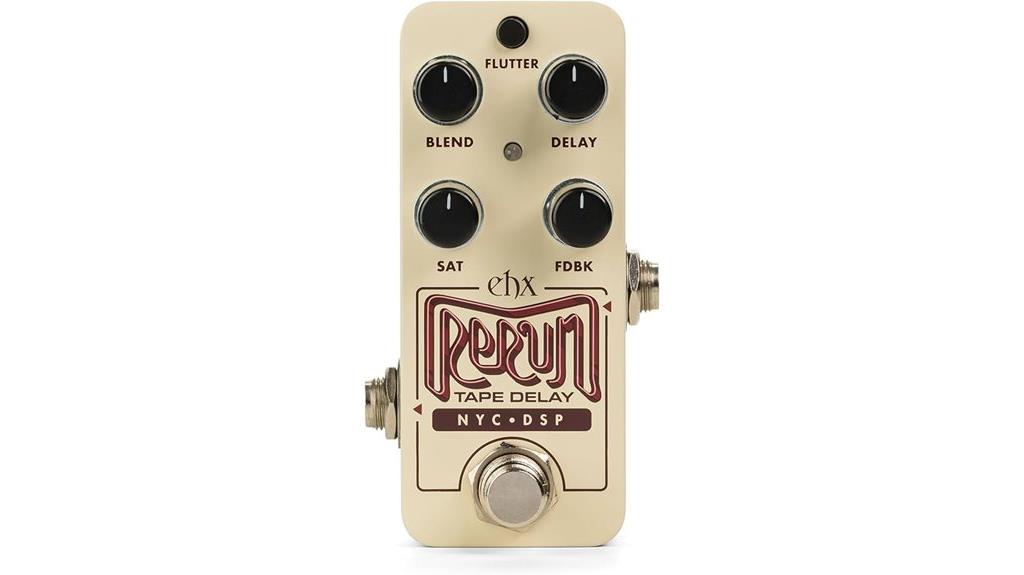
If you’re after authentic vintage tape delay sounds with versatile control, the Electro-Harmonix Pico Rerun Tape Delay Pedal is an excellent choice. It features a tape delay algorithm derived from the Canyon Delay and Looper, giving you classic tape echo effects. You can easily set the delay time from 8 milliseconds up to 3 seconds, perfect for everything from slapback to long ambient repeats. The SAT control lets you dial in tape saturation and distortion, adding warmth and grit. With the FLUTTER toggle, you can select from three levels of warbly, degraded tape modulation, giving your sound that nostalgic, vintage vibe.
Best For: musicians and producers seeking authentic vintage tape delay sounds with versatile controls for both subtle echoes and dramatic effects.
Pros:
- Emulates classic tape delay with warm saturation and warbly modulation
- Wide delay time range from 8ms to 3s for versatile applications
- Easy-to-use controls for blending, saturation, and modulation levels
Cons:
- May require fine-tuning to achieve specific vintage tape effects
- Limited to delay effects, lacks additional modulation or reverb options
- Potentially more complex for beginners unfamiliar with delay parameters
Strymon Deco Tape Saturation and Doubletracker Delay Pedal
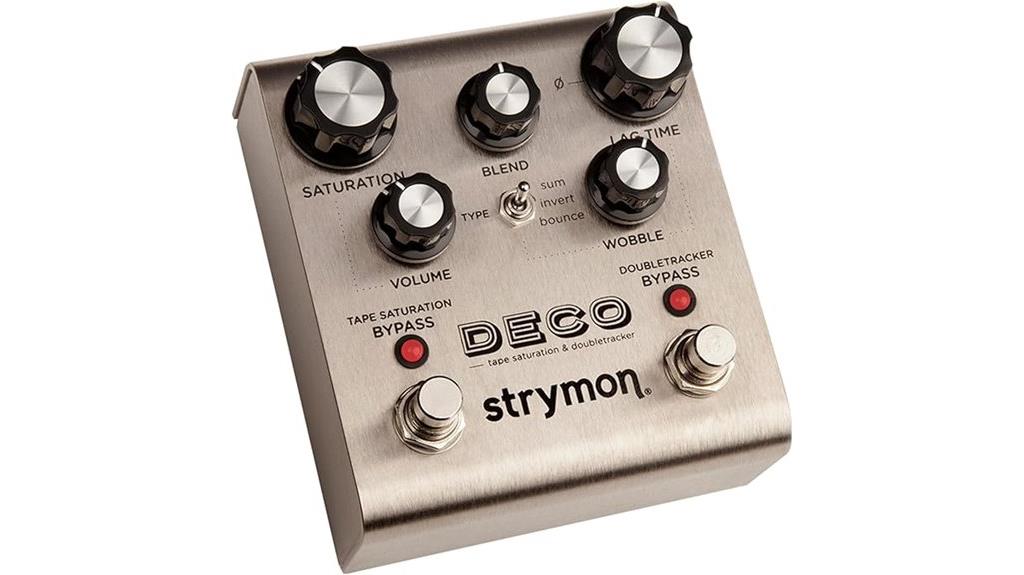
Musicians seeking authentic vintage tape sounds will find the Strymon Deco Tape Saturation and Doubletracker Pedal an ideal choice, especially for those who want versatile effects in a compact pedal. It emulates classic tape characteristics like harmonic saturation, double-tracking, flanging, chorusing, and tape delay, all adjustable to suit your tone. With its intuitive controls and rich sound-shaping options, Deco makes it easy to add warmth and depth to your sound on stage or in the studio. Its durable build and compact size make it perfect for pedalboards, while its authentic tape emulation elevates your music with vintage charm and modern flexibility.
Best For: guitarists and musicians seeking authentic vintage tape effects and versatile sound-shaping capabilities in a compact, durable pedal suitable for live and studio use.
Pros:
- Emulates classic tape saturation, double-tracking, and tape delay with rich, authentic sound.
- Highly adjustable parameters for tailored tone shaping and versatile effects.
- Compact and durable design ideal for pedalboards and performance environments.
Cons:
- Slight learning curve for beginners to fully explore all features.
- May require additional pedals or equipment for complex setups.
- Slightly higher price point compared to basic effects pedals.
Factors to Consider When Choosing Lo‑Fi Tape Emulation Pedals

When selecting a lo-fi tape emulation pedal, I consider how authentic the sound is and how well it captures vintage tones. I also look at the range of effects it offers, along with user-friendly controls that make it easy to shape my sound. Ultimately, build quality, compatibility with my gear, and overall durability are key factors that influence my decision.
Sound Authenticity and Tone
Achieving authentic lo-fi tape emulation hinges on how convincingly a pedal reproduces the distinct characteristics of vintage tape machines. I look for pedals that deliver warm, degraded, and warbly tones that evoke nostalgia. Features like tape saturation and distortion controls are essential, as they add natural compression and harmonic richness, making the sound more authentic. Variations in modulation, such as flutter levels, contribute to the imperfect, organic feel that’s so characteristic of analog tape. Additionally, pedals with analog dry signal paths and tape-specific algorithms help preserve subtle nuances and natural decay, closely mimicking real tape recordings. Ultimately, the true test of authenticity lies in how well the pedal reproduces tape artifacts like wow, flutter, and degradation—those imperfections that give vintage tape sound its unique charm.
Effect Versatility & Range
A lo-fi tape emulation pedal’s effect versatility largely depends on its range of delay times, saturation levels, and modulation options. A broader range allows for more creative expression, from subtle vintage warmth to heavily degraded tape sounds. Pedals with multiple modulation modes, like flanging, chorusing, or warbly effects, expand the sonic palette, adding unique textures. Adjustable parameters such as saturation, flutter, and warble levels let me fine-tune the lo-fi character to suit different musical contexts. Additionally, the ability to seamlessly blend dry and wet signals enhances versatility, enabling subtle enhancement or dramatic effects. When choosing a pedal, I look for one that offers a wide effect range and multiple effect types, so I can craft everything from simple tape warmth to complex, textured soundscapes.
User Interface & Controls
How intuitive the controls are can make a big difference in how effectively I can shape my sound with a lo-fi tape emulation pedal. Clear, labeled controls let me make quick adjustments without second-guessing, which is vital during live performances or quick studio sessions. Multiple dedicated knobs for parameters like delay time, saturation, modulation, and feedback give me precise control over my tone, making it easier to craft the vintage warmth I seek. Some pedals include toggle switches or buttons for different modes, adding versatility without cluttering the layout. Visual indicators like LEDs or meters are also helpful—they let me monitor effect status and changes in real time. An intuitive interface makes experimenting fun and hassle-free, ensuring I spend less time fiddling and more time creating.
Build Quality & Durability
Selecting a lo-fi tape emulation pedal with solid build quality is vital for guaranteeing it can withstand regular use and transport. I recommend looking for pedals crafted from high-quality, sturdy materials like metal enclosures, which resist damage from everyday handling. Robust switch mechanisms and well-secured jacks are essential to prevent connectivity issues over time. Additionally, consider how well the pedal resists dust, moisture, and temperature fluctuations—these factors greatly impact longevity. A well-designed, compact, and lightweight pedal strikes a good balance between portability and durability. Reading user reviews can also provide insight into real-world reliability, highlighting any common issues with component wear or failure. Prioritizing build quality ensures your pedal remains dependable and performs consistently for years to come.
Compatibility With Gear
Ensuring your lo-fi tape emulation pedal is compatible with your existing gear is crucial for seamless integration and ideal sound quality. First, check that the pedal’s input and output connections match your setup, such as 1/4-inch instrument or line-level jacks. Next, verify the pedal’s voltage requirements, typically 9V, align with your power supply or pedalboard setup to prevent issues. Also, confirm that the signal format—analog or digital—is compatible with your other effects and instruments, ensuring maximum sound integrity. Consider how the pedal fits into your pedalchain, especially regarding placement and bypass systems. Finally, assess whether the control interface, like knobs, switches, or MIDI, suits your workflow, making live use or recording straightforward and intuitive.
Pricing & Value
When choosing a lo-fi tape emulation pedal, considering its price and overall value is essential to getting the best sound for your budget. Budget options usually cost under $100, while high-end models can exceed $300. The value you get depends on tape saturation quality, modulation options, and added features relative to the cost. Cheaper pedals might have fewer controls and less authentic tape sounds, making them less ideal for professional use. Investing in a pricier pedal often means better build quality, more versatile sound shaping, and longer-lasting components. Comparing features and reading user reviews can help you determine whether a pedal’s price reflects its ability to deliver genuine lo-fi tape warmth and overall value for your specific needs.
Frequently Asked Questions
Can These Pedals Be Used With Both Guitar and Bass?
Yes, these pedals can be used with both guitar and bass. I’ve tried them with my guitar and bass, and they add a warm, vintage vibe to either instrument. The controls are versatile, allowing me to shape the sound to suit different styles. Just keep in mind that some pedals might respond differently depending on your instrument’s pickups and output, so it’s worth experimenting to find the perfect tone.
Do Lo-Fi Tape Emulation Pedals Require Special Power Supplies?
No, lo-fi tape emulation pedals generally don’t need special power supplies. Most run on standard 9V or 18V adapters, making them easy to integrate into your setup. I’ve used several with regular power supplies without any issues. Just double-check the pedal’s specifications to confirm compatibility. This way, you can focus on creating vintage warmth without worrying about complicated power requirements.
Are These Pedals Suitable for Live Performance or Studio Use?
Yes, I find these pedals great for both live performance and studio use. They’re versatile and sturdy enough for gigs, giving my sound a unique vintage warmth that really stands out. In the studio, they help me craft that nostalgic vibe effortlessly. Just make sure you’ve got the right power supply, and you’re good to go. Whether I’m recording or playing live, these pedals add character to my tone.
How Do Tape Emulation Pedals Impact Overall Mix Clarity?
Imagine a vintage record spinning softly in the background—tape emulation pedals add that warmth and character, but they can also muddy the mix if overused. I’ve found they impact clarity by introducing subtle saturation and compression, which can soften edges but sometimes obscure fine details. When used sparingly, they enhance depth without sacrificing overall transparency, giving your sound a nostalgic glow while keeping everything clear and balanced.
Do These Pedals Introduce Any Noticeable Latency or Signal Loss?
No, these pedals generally don’t introduce noticeable latency or signal loss. I’ve used them in my setup, and the effect feels seamless, adding warmth without sacrificing clarity or speed. Modern tape emulation pedals are designed to maintain a clean, responsive signal path while imparting that vintage character. So, you can enjoy the nostalgic vibe without worrying about delays or reduced audio fidelity.
Conclusion
If you’re after that elusive vintage warmth that can transform your sound, these pedals are absolute game-changers. They’re like magic wands, turning your rig into a vintage recording studio in an instant. Whether you’re after lush tape delay or gritty saturation, these four pedals will elevate your tone to legendary status. Trust me, once you try them, you’ll wonder how you ever recorded without them—your sound will become a timeless masterpiece.
